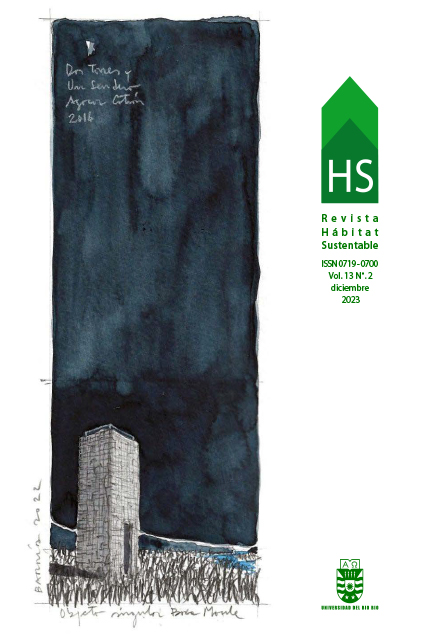Construcción de modelos matemáticos simples para el cálculo del requerimiento energético de edificaciones
DOI:
https://doi.org/10.22320/07190700.2023.13.02.04Palabras clave:
modelo matemático, simulaciones, arquitectura sustentableResumen
El presente trabajo tiene por objetivo desarrollar un modelo matemático predictivo que otorgue un primer acercamiento al valor de requerimiento energético (RE) de un edificio en un clima templado continental, con el propósito de aportar al conocimiento teórico sobre herramientas de evaluación energética. Se realizaron simulaciones paramétricas procesadas con los programas EnergyPlus 9.5 y JePlus. Los resultados fueron utilizados como Dataset para el armado de diferentes modelos matemáticos, para los cuales se utilizó el programa SageMath a fin de desarrollar ecuaciones que predigan el RE de cada escenario. Se trabajó con modelos escalonando su complejidad en cuanto a métodos utilizados y cantidad de parámetros. Se seleccionó un modelo con bajo nivel de error (0.08) y 15 parámetros. Se advirtió que, si bien el aumentar la cantidad de parámetros acercaba los modelos al error 0.02, se corría el peligro de overfitting. El modelo seleccionado busca incorporar la precisión y validez de las simulaciones dinámicas a una herramienta de predicción sencilla y aplicable por profesionales de la construcción.
Descargas
Citas
AZAR, E., ALAIFAN, B., LIN, M., TREPCI, E., & ASMAR, M. E. (2021). Drivers of energy consumption in Kuwaiti buildings: insights from a hybrid statistical and building performance simulation approach. Energy Policy, 150, 112154. https://doi.org/10.1016/j.enpol.2021.112154
CĂTĂLINA, T., IORDACHE, V., & CARACALEANU, B. (2013). Multiple regression model for fast prediction of the heating energy demand. Energy and Buildings, 57, 302–312. https://doi.org/10.1016/j.enbuild.2012.11.010
CHANG, C. C., SHI, W., MEHTA, P., & DAUWELS, J. (2019). Life cycle energy assessment of university buildings in tropical climate. Journal of Cleaner Production, 239, 117930. https://doi.org/10.1016/j.jclepro.2019.117930
CHOU, J., & NGO, N. (2016). Time series analytics using sliding window metaheuristic optimization-based machine learning system for identifying building energy consumption patterns. Applied Energy, 177, 751–770. https://doi.org/10.1016/j.apenergy.2016.05.074
GONZÁLEZ-VIDAL, A., RAMALLO-GONZÁLEZ, A. P., TERROSO-SÁENZ, F., & SKARMETA, A. F. (2017). Data driven modeling for energy consumption prediction in smart buildings. 2017 IEEE International Conference on Big Data (Big Data). https://doi.org/10.1109/bigdata.2017.8258499
HUANG, S., LIN, Y., CHINDE, V., MA, X., & LIAN, J. (2021). Simulation-based performance evaluation of model predictive control for building energy systems. Applied Energy, 281, 116027. https://doi.org/10.1016/j.apenergy.2020.116027
INTERNATIONAL ENERGY AGENCY (2022). Tracking Buildings 2022. Paris: International Energy Agency. https://www.iea.org/ energy-system/buildings
KWAK, Y. H., SEO, D., JANG, C., & HUH, J. (2013). Feasibility study on a novel methodology for short-term real-time energy demand prediction using weather forecasting data. Energy and Buildings, 57, 250–260. https://doi.org/10.1016/j.enbuild.2012.10.041
MALKAWI, A., & AUGENBROE, G. (2004). Advanced Building Simulation. Routledge. https://doi.org/10.4324/9780203073674
PAPADOPOULOS, S., AZAR, E., WOON, W. L., & KONTOKOSTA, C. E. (2017). Evaluation of tree-based ensemble learning algorithms for building energy performance estimation Journal of Building Performance Simulation, 11(3), 322–332. https://doi.org/10.1080/19401493.2017.1354919
RAJ, B. P., MEENA, C. S., AGARWAL, N., SAINI, L., KHAHRO, S. H., SUBRAMANIAM, U., & GHOSH, A. (2021). A Review on Numerical Approach to Achieve Building Energy Efficiency for Energy, Economy and Environment (3E) benefit. Energies, 14(15), 4487. https://doi.org/10.3390/en14154487
SCHWARTZ, Y., & RASLAN, R. (2013). Variations in results of building energy simulation tools, and their impact on BREEAM and LEED ratings: A case study. Energy and Buildings, 62, 350–359. https://doi.org/10.1016/j.enbuild.2013.03.022
SEYEDZADEH, S., RAHIMIAN, F. P., RASTOGI, P., & GLESK, I. (2019). Tuning machine learning models for prediction of building energy loads. Sustainable Cities and Society, 47, 101484. https://doi.org/10.1016/j.scs.2019.101484
HARPUTLUGIL, T., & DE WILDE, P. (2021). The interaction between humans and buildings for energy efficiency: A critical review. Energy Research & Social Science, 71, 101828. https://doi.org/10.1016/j.erss.2020.101828
UNITED NATIONS ENVIRONMENT PROGRAMME (2022). 2022 Global Status Report for Buildings and Construction: Towards a Zero emission, Efficient and Resilient Buildings and Construction Sector. https://www.unep.org/resources/publication/2022-global-status-report-buildings-and-construction
FANG, Y., & CHO, S. (2019). Design optimization of building geometry and fenestration for daylighting and energy performance. Solar Energy, 191, 7–18. https://doi.org/10.1016/j.solener.2019.08.039
YE, Y., HINKELMAN, K., ZHANG, J., ZUO, W., & WANG, G. (2019). A methodology to create prototypical building energy models for existing buildings: A case study on U.S. religious worship buildings. Energy and Buildings, 194, 351–365. https://doi.org/10.1016/j.enbuild.2019.04.037
ZHAO, H., & MAGOULÈS, F. (2012). A review on the prediction of building energy consumption. Renewable & Sustainable Energy Reviews, 16(6), 3586–3592. https://doi.org/10.1016/j. rser.2012.02.049
Descargas
Publicado
Cómo citar
Número
Sección
Licencia
Derechos de autor 2023 María Victoria Mercado, Gustavo Javier Barea-Paci, Andrés Esteban Aceña

Esta obra está bajo una licencia internacional Creative Commons Atribución-CompartirIgual 4.0.
El contenido de los artículos que se publican en cada número de Hábitat Sustentable, es responsabilidad exclusiva de los autores y no representan necesariamente el pensamiento ni comprometen la opinión de la Universidad del Bío-Bío.
Los autores/as conservarán sus derechos de autor y garantizarán a la revista el derecho de primera publicación de su obra, el cuál estará simultáneamente sujeto a la Licencia de Reconocimiento de Creative Commons CC BY-SA que permite a otros compartir-copiar, transformar o crear nuevo material a partir de esta obra con fines no comerciales, siempre y cuando se reconozcan la autoría y la primera publicación en esta revista, y sus nuevas creaciones estén bajo una licencia con los mismos términos.











 Programa de Información Científica/Concurso Fondos de Publicación de Revistas Científicas 2018/ Proyecto Mejoramiento de Visibilidad de Revistas UBB (Código:FP180007)
Programa de Información Científica/Concurso Fondos de Publicación de Revistas Científicas 2018/ Proyecto Mejoramiento de Visibilidad de Revistas UBB (Código:FP180007) 





